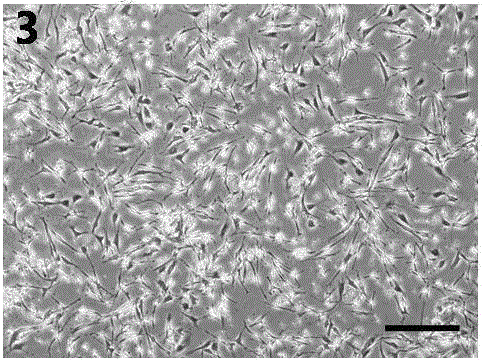Method for repairing nerve defects in tissue engineering
An engineering and neurological technology, applied in the field of cell biology, can solve problems such as limiting the clinical application of stem cells, and achieve the effect of avoiding tumorigenicity, broad clinical application prospects and clinical value, and maintaining activity.
- Summary
- Abstract
- Description
- Claims
- Application Information
AI Technical Summary
Problems solved by technology
Method used
Image
Examples
Embodiment 1
[0046] Example 1 : Isolation, purification, and enrichment of fat-derived Schwann cells
[0047] Newborn 7-day-old C57 mice were put into 75% alcohol and soaked for 5-10 minutes after routine treatment.
[0048] 1. Under sterile conditions, take the adipose tissue of Linti mice, cut it into pieces, and use 0.1-0.2% compound collagenase NB4 and 0.05-0.1% Dispase mixed enzyme solution with a mass volume ratio of 5-20 times the tissue volume Digest the pieces for 60 minutes;
[0049] 2. Centrifuge the dissolved tissue in step 1 at 1500r for 5 minutes, discard the supernatant, and obtain cell pellets;
[0050] 3. Resuspend the cells obtained in step 2 with Schwann cell culture medium (DMEM medium containing 2μM forskolin, 10ng / ml heregulin-β-1, 10ng / ml BFGF), count, and press 1x10 4 -5x10 4 piece / cm 2 Inoculated on Petri dishes. Set at 37°C, 5% CO 2 incubator cultivation;
[0051] 4. After the cells were cultured for 48-72 hours, the cells were purified with 0.2% DIspase...
Embodiment 2
[0054] Example 2: Adipose-derived Schwann cells repairing sciatic nerve defect in mice
[0055] a) After the cells were cultured for 48-72 hours in step 5 in Example 1, the culture medium was sucked off, the Schwann cells were digested with 0.25% trypsin for 1 minute, DMEM neutralized the trypsin, and the cell suspension was collected;
[0056] b) centrifuge the cell suspension obtained in step a at 100 rpm for 5 minutes, and discard the supernatant;
[0057] c) Resuspend the cells obtained in step b in a mixture of Schwann cell culture medium (SCCM) and Matrigel glue, and make a mixture of SCCM and Matrigel glue at a ratio of 1:1;
[0058] d) Pipette the suspension obtained in step c repeatedly for 3-5 minutes to fully mix the cells. Both steps c and d need to be operated on ice at 4°C;
[0059] e) The mice were anesthetized with 5% chloral hydrate (6ml / kg) intraperitoneally, and the right sciatic nerve was exposed;
[0060] f) Use silicone tubes to make artificial nerve...
Embodiment 3
[0064] Example 3 Adipose-derived Schwann cells and adipose-derived stem cells repair sciatic nerve defects respectively
[0065] 1) Acquisition of adipose-derived Schwann cells and adipose stem cells
[0066] Acquisition of Schwann cells: as described in Example 1.
[0067] Obtaining fat stem cells:
[0068] 1. Mice were routinely treated, soaked in 75% ethanol for 10 minutes, and adipose tissue was taken under aseptic conditions, placed in a disposable centrifuge tube, and cut into pieces to a size of 1 mm×1 mm×1 mm;
[0069] 2. Add 10-15ml 0.2% NB4 and 5-10 ml 0.2% Dispase, shake and digest for about 60 minutes;
[0070] 3. Centrifuge the dissolved tissue in step 2 at 1500rpm for 5 minutes, discard the supernatant, and obtain cell pellets;
[0071] 4. Add 8ml of DMEM culture medium to resuspend the cells, press about 1×10 4 / cm 2 Density Inoculate the cells into culture flasks and place them in a 37°C, 5% CO2 incubator for culture;
[0072] 5. When the primary cells ...
PUM
 Login to View More
Login to View More Abstract
Description
Claims
Application Information
 Login to View More
Login to View More - R&D
- Intellectual Property
- Life Sciences
- Materials
- Tech Scout
- Unparalleled Data Quality
- Higher Quality Content
- 60% Fewer Hallucinations
Browse by: Latest US Patents, China's latest patents, Technical Efficacy Thesaurus, Application Domain, Technology Topic, Popular Technical Reports.
© 2025 PatSnap. All rights reserved.Legal|Privacy policy|Modern Slavery Act Transparency Statement|Sitemap|About US| Contact US: help@patsnap.com



